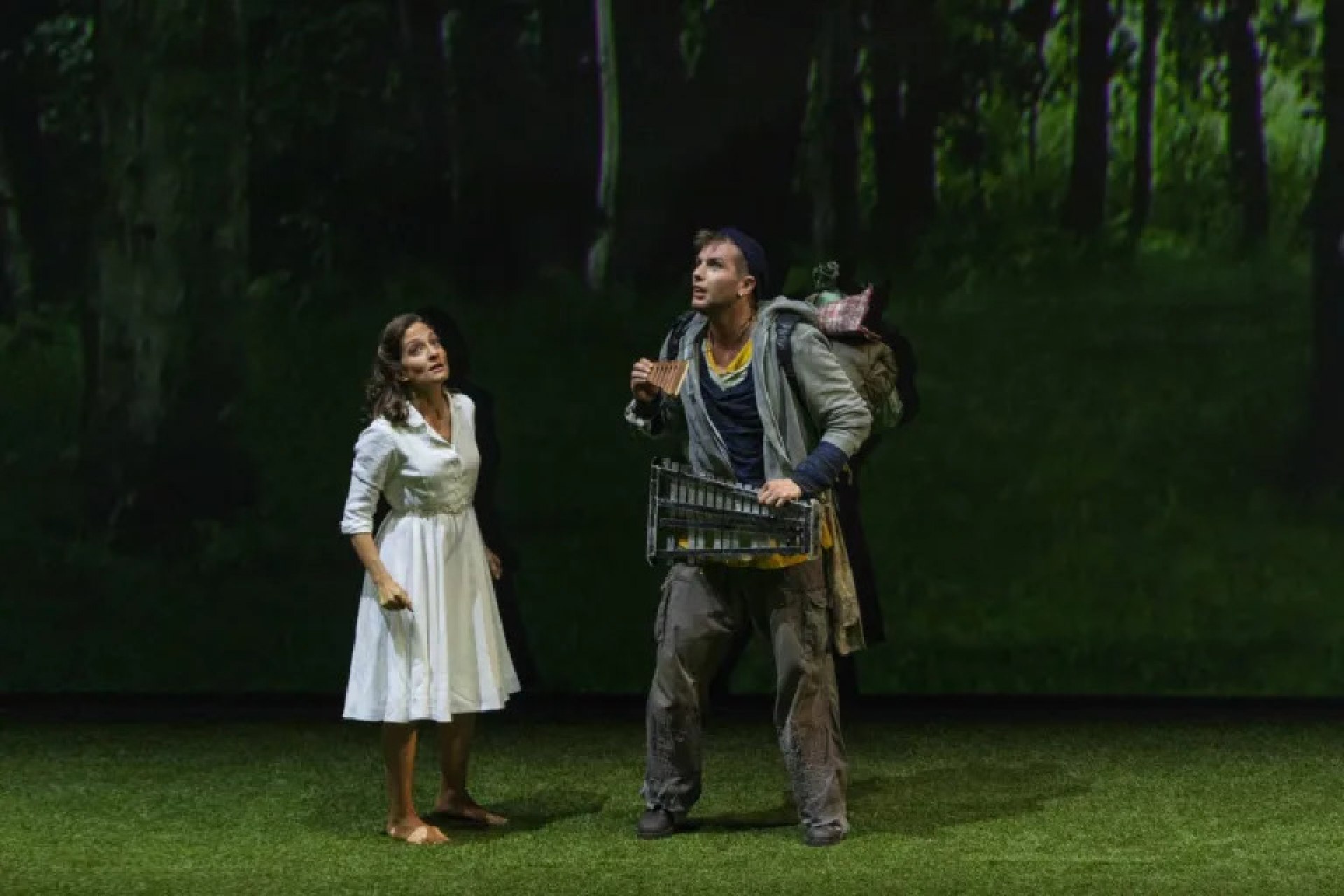The Magic Flute
Mo | Tu | We | Th | Fr | Sa | Su |
First part
Act1
Tamino is threatened by an enormous snake and falls unconscious. Three ladies appear and kill the snake. They discover the handsome young man and leave to inform the Queen of the Night. Tamino wakes up and meets Papageno, the Queen of the Night’s bird-catcher. When Papageno accepts credit for having killed the snake, the three ladies reappear and lock his mouth to punish him for lying. They show Tamino a picture of the Queen’s daughter Pamina, and he immediately falls in love with her.
The Queen herself appears and begs Tamino to rescue her daughter from Sarastro, who has kidnapped her. The ladies now free Papageno, and give Tamino a magic flute and Papageno a set of magic bells to protect them, telling them that three boys will guide them on their journey. Within Sarastro’s walls, Monostatos is attempting to rape Pamina, but runs away when he is frightened by Papageno. The bird-catcher tells Pamina that Tamino has fallen in love with her and that they have come to her rescue. Pamina rejoices. She and Papageno both dream of finding someone to love. The three boys guide Tamino to Sarastro’s temple. A priest appears and warns Tamino that things may not be as they seem. Unknown voices inform Tamino that Pamina is still alive. Overjoyed, Tamino plays the magic flute and, hearing Papageno calling him, leaves in search of the latter and Pamina. It is Monostatos and his followers however who soon find them.
As they are about to arrest them, Papageno plays his magic bells which render the attackers harmless. Sarastro appears and tells Pamina she is free to choose whom she will love, but not yet free to leave his realm. Monostatos drags in Tamino and demands a reward, but is punished instead. As Tamino and Pamina acknowledge their love, Sarastro orders the priests to take Tamino and Papageno into the temple for purification.
Second part
Act2
The trials commence. The priests swear Tamino and Papageno to silence, which both prove able to maintain to varying degrees. Tamino even rejects the charms of the three ladies and successfully passes his first challenge. The Queen of the Night appears, instructing her daughter Pamina to kill Sarastro. Pamina resists. The three boys help Tamino and Papageno to pass the next challenge: Tamino, who has been ordered to stay silent, meets Pamina. She feels rejected by his refusal to speak to her.
Sarastro praises Tamino for his steadfastness and summons the two lovers. But Pamina is in despair. The three boys come to the rescue and talk her out of killing herself, and now she wants to undergo the remaining challenges together with Tamino. Protected by their love for each other, they pass trials by water and by fire. Papageno eagerly awaits his reunion with Papagena, whom he has been allowed to meet despite his poor performance in the trials. Separated from her once again, he too contemplates suicide, only to be stopped by the three boys.
His magic bells spirit Papagena into his company. Monastatos joins forces with the Queen of the Night and the three ladies. Together they launch one final attempt to test Pamina’s and Tamino’s love. At that moment Sarastro and the priests appear on the scene to announce the beginning of a new dawn and to welcome the newcomers amongst the initiated.
CHARACTERS
Tamino: In love with Pamina.
Papageno: Bird-catcher in the service of the Queen of the Night.
Sarastro: High Priest in the Temple of Wisdom.
La Reine de la Nuit: Pamina’s mother.
Pamina: The Queen of the Night’s daughter.
Monostatos: Sarastro’s servant.
Papagena: Promised to Papageno.
Les trois Dames: In the service of the Queen of the Night
Program and cast
Singspiel in two acts (1791)
Creative team
Wolfgang Amadeus Mozart - Music
Emanuel Schikaneder - Libretto
Oksana Lyniv - Conductor
Alessandro Di Stefano - Chorus master
Robert Carsen - Staging and lighting
Michael Levine - Set design
Petra Reinhardt - Costume design
Peter van Praet - Lighting design
Martin Eidenberger - Video
Ian Burton - Dramaturgy
Cast
Pavol Breslik - Tamino
Nikola Hillebrand - Pamina
Aleksandra Olczyk - Königin der Nacht
Jean Teitgen - Sarastro
Mathias Vidal - Monostatos
Mikhail Timoshenko - Papageno
Ilanah Lobel-Torres - Papagena
Nicolas Cavallier - Der Sprecher
Margarita Polonskaya - Erste Dame
Marie-Andrée Bouchard-Lesieur - Zweite Dame
Claudia Huckle - Dritte Dame
Niall Anderson - Erster Priester, Zweiter Geharnischter Mann
Nicholas Jones - Zweiter Priester, Erster Geharnischter Mann
Maîtrise des Hauts de Seine - Drei Knaben
Orchestre et Chœurs de l'Opéra national de Paris
Maîtrise des Hauts-de Seine/Chœur d’enfants de l’Opéra national de Paris
Coproduction avec le Festspielhaus, Baden-Baden
Language : German
Surtitle : French / English
Duration :
Opening
First part - 70 minutes
Intermission - 30 minutes
Second part - 85 minutes
End
Paris Opera Bastille
RM Europa Ticket GmbH is an officially accredited ticket reseller of/by Opera National de Paris.
Agency number: 4848428
Opéra Bastille
A great modern theatre
The Opéra Bastille is the work of the Canadian-Uruguayan architect Carlos Ott, who was chosen in November 1983 after an international competition that attracted entries from some 1,700 architects. The theatre was inaugurated on July 13th 1989.
Its architecture is marked by transparent façades and by the use of identical materials for both the interiors and the exteriors.
With its 2,700 acoustically consistent seats, its unique stage facilities, its integrated scenery, costume and accessory workshops, as well as its numerous work areas and rehearsal rooms, the Opera Bastille is a great modern theatre.
Stage facilities
Orchestra pit, mobile and adjustable, can be covered; at its largest it can house 130 musicians
Main stage, 45 m high, 30 m wide, 25 m deep, made up of 9 elevators allowing several levels to be created and supported by three main elevators, which bring scenery up from below stage
Clearing zones, 4 storage areas with the same dimensions as the stage
Backstage area, with its scenery turntable
Circulation area, scenery temporarily stored between the stage, workshops and rehearsal stage
Rehearsal stage, the Salle Gounod, with its orchestra pit and dimensions identical to those of the main stage
The building
Area at ground level: 22,000 m²
Floor area: 160,000 m²
Total height: 80 m (including 30 m below street level)
The auditoriums
The main auditorium
Area: 1,200 m², 5% of the total for the building
Dimensions: 20 m high, 32 m deep, 40 m wide
Number of seats: 2,703
Materials: blue granite from Lannelin in Brittany, pearwood from China, glass ceiling
The amphitheatre
Area: 700 m²
Depth : 21.4 m
Number of seats : 450
Materials: white breccia marble from Verona, staff ceiling
The Studio
Area: 280 m²
Depth: 19,5 m
Number of seats: 237
Materials: white breccia marble from Verona and pearwood

 EN
EN DE
DE IT
IT FR
FR ES
ES RU
RU JP
JP RO
RO
 Seating plan
Seating plan